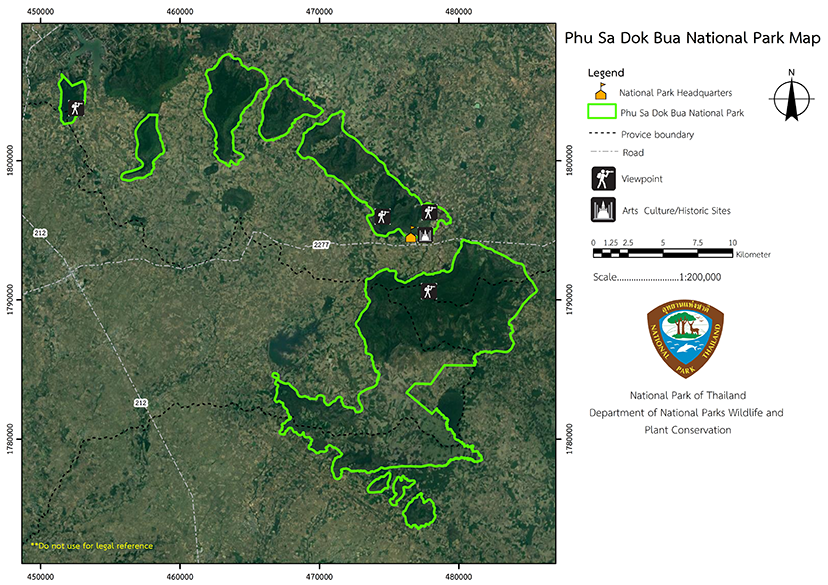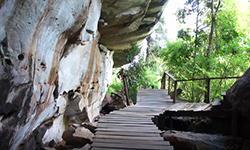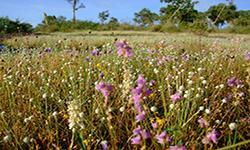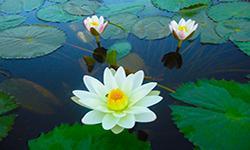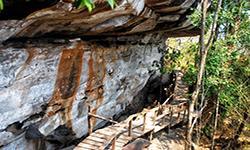Phu Sa Dok Bua National Park
Contact Location : Phu Sa Dok Bua National Park Headquarter, Ban Nong Mek, Pa Rai Sub-district, Don Tan District Mukdahan Province 49120
Telephone Number : (+66) 4 262 0615 Administration Department (+66) 8 9720 1002
Department of Recreation and Academic Affairs 065 067 1185 Department of Conservation and Protection of Resources (+66) 8 9032 5369
Email : phusadokbua@hotmail.com
Facebook : Phu Sa Dok Bua National Park
Information
-
Background
-
Note : After paying the entrance fee to the National Park, please carry the receipt for inspection.
144375.00 rai (231 square kilometers)
|
|
|
||
|
Phu Wat |
Phu Sa Dok Bua |
||
|
|
|||
-
Welfare shop : Not available.
Mobile phone signal :
National Park Headquarters: AIS, TRUE, DTACฃ
|
|
Phu Sa Dok Bua National Park has a total area of approximately 144,375 rai, or 231 square kilometers. The terrain is generally a complex mountain range consisting of many mountains. These mountain ranges are part of a large mountain range known as the Phu Phan Mountains range, elongating from the northeast to the southeast and separating the Khorat Plateau into 2 basins. The northern part is the Sakon Nakhon Basin, and the southern part is the large basin, which is the Khorat-Ubon basin. Rock characteristics and tectonic changes in the past that occured within the area of Phu Sa Bua National Park, making it interesting for geological and geographical studies, especially the occurrence of the erosion of sand stones that turn into cliffs, a pothole, or a rock basin on the top of the mountain and the formation of faults. Therefore, this area has not only .become a tourist attraction but also a place to study the changes in nature. The internal and external changes in the Earth's crust from the past to the present formed many moutains in Phu Sa Dok Bua National Park such as Phu Mu, Phu Phaeng Ma, Phu Mai Sang, Phu Khong, Phu Akkhara-at, Phu Tafia, Phu Pha Dang, Phu Pha Hom, Phu Pong Pueai, Phu Nat, Phu Kasa, Phu Hua Nak, Phu Pha Sango, Phu Salun, Phu Tham Phra, Phu Sa Dok Bua There is also a peak called Phu Mai Sang which is the highest peak at about 494 meters above mean sea level, and other mountain peaks have an average height of 350-450 meters above mean sea level. These areas are also the sources of many streams such as Thom Creek, Hai Creek, Tup Creek, Kan Lueang Creek, Lam Klang Creek, Khilek Creek, Hin Khua Creek, Ching Hing Creek, etc. These streams flow into the plain surrounding the national park area, the people around Phu Sa Dok Bua National Park have been using the water for consumption and agriculture since in the past. Water Resources Characteristics of canals in Phu Sa Dok Bua National Park are mostly short, flowing in the direction from the west to the east, consisting of Bang Yi Creek, Thom Creek, Hai Creek, Tup Creek, Kan Lueang Creek, Lam-Klang Creek, Khilek Creek, Hin Khong Creek, Ching Hing Creek, etc., which originate from the Mekong River. Another important surface water sources in the vicinity of Phu Sa Dok Bua National Park are the Huai Hin Kho Reservoir, Huai Nang Wan Reservoir, Huai Khilek Reservoir (Ban Phu Pha Hom), Huai Kan Lueang Reservoir, Huai Khilek Reservoir (Khan Dan Mon), Huai Wang Tao Reservoir, Huai Ka Lom Reservoir, Huai Sabaek Reservoir, Huai Kaeng Wa Reservoir, etc. |
|
Climate characteristics
|
|
|
|
|
Flora and Wildlife in Phu Sa Dok Bua National Park consists of 2. Mixed deciduous forest is found in the central area and along the southern part of the area and the northwestern slope. The canopy can be divided into 3 layers. The top canopy is about 18-30 meters in height, and the main species of the canopy include Xylia xylocarpa , Lagerstroemia duperreana, Burma Padauk, Millettia leucantha., Dillenia obovata, Schleichera oleosa, Albizia odoratissima and Cratoxylum cochinchinense. so on. The secondary canopy has a height of about 8 3. The Dry Forest (Dry Evegreen Forest) is found in the central area and the lower area, but it is only a small patch because the soil is quite deep and holds moisture well enough. The structure is divided into 3 layers. The top canopy is about 20-40 meters high. The important plants in this canopy are Anisoptera costata (Mesawa), Dipterocarpus, Parinari anamense , and Nephelium hypoleucum. The secondary canopy has a height of about 18 meters. It is quite dense, the contiguous canopy of trees can be seen from above. The important plants in this class are Polyalthia viridis, Microcos tomentosa Smith., Indigofera sootepensis ., Diospyros filipendula, Memecylon caeruleum., Shorea roxburghii, Croton oblongifolius Roxb., Irvingia malayana, etc. The layer of small plants and shrubs is more than 8 meters in height, quite densely, mixed with the juveniles of the secondary and upper trees. The most common are Rothmannia wittii (Craib.) Bremek., Indigofera lacei, and Roman Iron Wood. The undergrowth layer consists of various types of seedlings; the layer is dense mixed with many types of herbaceous plants, especially plants in the family of Zingiberaceae, Rubiaceae, Apocynaceae , Annonaceae and, etc. 4.Secondary Forest is formed after the area had been disturbed in the past (secondary forest) and the area is in the stage of the replacement (Successional Stage) at several levels. The variations in plant communities depend on the degree of severity of destruction, the time the areas were abandoned, and the conditions of the previous forest communities that existed before being destroyed. 5. Wildlife Because Phu Sa Dok Bua National Park is a new national park and there are many communities located both inside and outside the park boundaries. In addition, most of the forest is a sparse deciduous dipterocarp forest in which wildlife is seldom seen except Burmese hares, monkeys, squirrels, and various birds. It is assumed that large animals may have migrated to the area of Phu Pha Thoep National Park or were hunted to extinction. According to the survey of diversity of wildlife species, in it was found that wild animals consisting of mammals hat can be seen directly such as Treeshrew, Colugos, Burmese Hares, Indochinese ground squirrel, etc. Animals that only their traces are found are wild boars and barking deer, Birds are a fairly common group of animals that can be seen all over the area. They are mostly the birds that habitat in the Deciduous dipterocarp forest and mixed forest, five species of birds are found such as Bubulcus ibis, Greater Coucal., Black-winged Kite, Thick-billed Green Pigeon, Red Junglefowl, Common kingfishers, Tree Sparrow, Common Myna, Asian Barred Owlet, etc. 6. Reptiles found are Monocled cobras, Indochinese Rat Snake, Golden Tree snakes, House Gecko, Forest Crested lizards, Bronze grass skinks, Bengal monitor lizards, Varanus bengalensis and Common Forest skinks, and etc. 7. Fish: There is no survey of fish species in forest streams and streams with water all year round yet but it is believed that there are some kinds of fish in the area, especially around large creeks, including catfish, snakehead fish, , 8. Amphibians are found by light at night, for example, frogs, bullfrogs, and tortoises. 9. Forest insects are diurnal butterflies. It is another area with a great diversity of butterflies, which are still abundant. In addition, these insects can be found around the creeks with waterlogged or open areas such as Lemon Emigrant and Giant Moth. In addition, the kind of forest insects that are very beautiful and are found in large numbers during the rainy season in the deciduous dipterocarp forest are Sternocera ruficomisand Sternocera aequisignata with more Sternocera ruficomis are found more. 10. Cultural and historical resources in the area of Phu Sa Dok Bua National Park. Most of the people are ethnic people of Phu Tai, Kha, Ka Loeng, and Thai Isan tribes, each with different lifestyles. Their economy largely depends on natural resources and the environment. |
How to get there by car :
From Bangkok – Pass through Loeng Nok Tha District, Yasothon Province heading for Don Tan District, Mukdahan Province (on Provincial Route No. 2277), between the milestone No. 22- 23, turn north for about 1 kilometer to the of Phu Sa Dok Bua National Park Headquarters which is located at the Huai Hin Khong Reservoir in the Ban Nong Mek area of Pa Rai Sub-district in the province of Mukdahan.
- National Park Ranger Station at Pho Bo No. 2 (Dan Hin Taek)
- National Park Ranger Station at Pho Bo No. 1 (Phu Mu)
- National Park Ranger Station at Pho Bo No. 5 (Senangkhanikhom)
- National Park Ranger Station at Pho Bo No. 4 (Pha Dang)
- Phu Tham Phra extraction point
- National Park Ranger Station at Pho Bo No. 3 (Kueang Kaeo)
- Accommodation - Rim Tha Ra (101)
- Accommodation - The red-roof pailion
- Accommodation – The green-roof pavilion
- Others - helipad Other - Outdoor Stage Other - Wooden Bridge
- Other - Campfire and camping ground 2 Other - Kitchen
- Others - Drinking water tanks Others - Visitor Center
- Others - camping ground Others - rescue equipment

